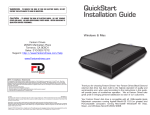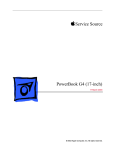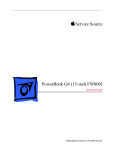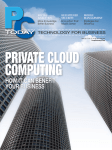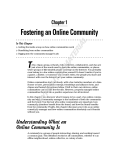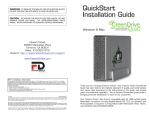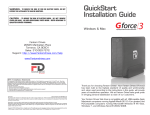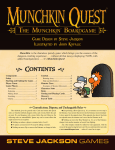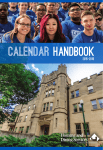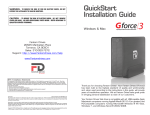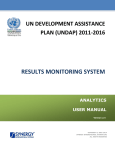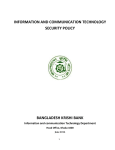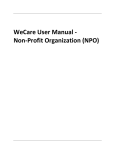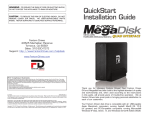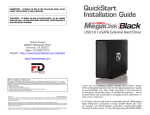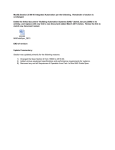Download Plug-In B3
Transcript
Confirming Pages P L U G - I N B3 Hardware and Software LEARN IN G OUT C O ME S 1. 2. 3. 4. 5. 6. Describe the six major categories of hardware and provide an example of each. Identify the different computer categories and explain their potential business uses. Explain the difference between primary and secondary storage. List the common input, output, storage, and communication devices. Describe the eight categories of computers by size. Define the relationship between operating system software and utility software. Introduction Managers need to determine what types of hardware and software will satisfy their current and future business needs, the right time to buy the equipment, and how to protect their IT investments. This does not imply that managers need to be experts in all areas of technology; however, building a basic understanding of hardware and software can help them make the right IT investment choices. Information technology (IT) is a field concerned with the use of technology in managing and processing information. Information technology can be composed of the Internet, a personal computer, a cell phone that can access the web, a personal digital assistant, or presentation software. All of these technologies help to perform specific information processing tasks. There are two basic categories of information technology: hardware and software. Hardware consists of the physical devices associated with a computer system. Software is the set of instructions that the hardware executes to carry out specific tasks. Software, such as Microsoft Excel, and various hardware devices, such as a keyboard and a monitor, interact to create a spreadsheet or a graph. This plug-in covers the basics of computer hardware and software including terminology, business uses, and common characteristics. Hardware Basics In many industries, exploiting computer hardware is key to gaining a competitive advantage. Frito-Lay gained a competitive advantage by using handheld devices to track the strategic placement and sale of items in convenience stores. Sales B3.2 * Plug-In B3 Hardware and Software baL76795_pluginb03_002-021.indd 2 8/4/09 3:24:38 PM Confirming Pages FIGURE B3.1 Six Hardware Components Central processing unit (CPU) The actual hardware that interprets and executes the program (software) instructions and coordinates how all the other hardware devices work together. Primary storage The computer’s main memory, which consists of the random access memory (RAM), the cache memory, and the read-only memory (ROM) that is directly accessible to the central processing unit (CPU). Secondary storage The equipment designed to store large volumes of data for long-term storage (e.g., diskette, hard drive, memory card, CD). Input devices The equipment used to capture information and commands (e.g., keyboard, scanner). Output devices The equipment used to see, hear, or otherwise accept the results of information processing requests (e.g., monitor, printer). Communication devices The equipment used to send information and receive it from one location to another (e.g., modem). Hardware Components of a Computer System * representatives could track sale price, competitor information, the number of items sold, and item location in the store all from their handheld device. A computer is an electronic device operating under the control of instructions stored in its own memory that can accept, manipulate, and store data. A computer system consists of six hardware components (see Figure B3.1). Figure B3.2 displays how these components work together to form a computer system. CENTRAL PROCESSING UNIT The dominant manufacturers of CPUs today include Intel (with its Celeron and Pentium lines for personal computers) and Advanced Micro Devices (AMD) (with its Athlon series). AMD was initially dismissed as a company that simply cloned current chips, producing processors that mimic the features and capabilities of those from industry leader Intel. However, over the past few years, AMD has begun introducing innovative CPUs that are forcing Intel into the unfamiliar position of reacting to competition. AMD led the way in transforming the processor market by creating chips that handle 64 bits of data at a time, up from 32 bits. It also broke new territory when it became the first provider of dual-core processors for the server market. Hector Ruiz, chairman and CEO of AMD, stated, “In our position there is only one thing we can do: Stay close to our customers and end users, understand what they need and want, and then simply out-innovate the competition. Innovation is at the center of our ability to succeed. We cannot win by just copying the competition.” The central processing unit (CPU) (or microprocessor) is the actual hardware that interprets and executes the program (software) instructions and coordinates how all the other hardware devices work together. The CPU is built on a small flake of silicon and can contain the equivalent of several million transistors. CPUs are unquestionably one of the 20th century’s greatest technological advances. A CPU contains two primary parts: control unit and arithmetic/logic unit. The control unit interprets software instructions and literally tells the other hardware devices what to do, based on the software instructions. The arithmetic-logic unit Plug-In B3 Hardware and Software baL76795_pluginb03_002-021.indd 3 * B3.3 8/4/09 3:24:38 PM Confirming Pages Output Device Input Device Primary Storage Device Central Processing Unit (CPU) Control Unit Arithmetic-Logic Unit Secondary Storage Device Communication Device FIGURE B3.2 How the Hardware Components Work Together (ALU) performs all arithmetic operations (for example, addition and subtraction) and all logic operations (such as sorting and comparing numbers). The control unit and ALU perform different functions. The control unit obtains instructions from the software. It then interprets the instructions, decides which tasks other devices perform, and finally tells each device to perform the task. The ALU responds to the control unit and does whatever it dictates, performing either arithmetic or logic operations. The number of CPU cycles per second determines how fast a CPU carries out the software instructions; more cycles per second means faster processing, and faster CPUs cost more than their slower counterparts. CPU speed is usually quoted in megahertz and gigahertz. Megahertz (MHz) is the number of millions of CPU cycles per second. Gigahertz (GHz) is the number of billions of CPU cycles per second. Figure B3.3 displays the factors that determine CPU speed. Advances in CPU Design Chip makers are pressing more functionality into CPU technology. Most CPUs are complex instruction set computer (CISC) chips, which is a type of CPU that can recognize as many as 100 or more instructions, enough to carry out most computations directly. Reduced instruction set computer (RISC) chips limit the number of instructions the CPU can execute to increase processing speed. The idea of RISC is to reduce the instruction set to the bare minimum, emphasizing the instructions used most of the time and optimizing them for the fastest possible execution. A RISC processor runs faster than a CISC processor. B3.4 * Plug-In B3 Hardware and Software baL76795_pluginb03_002-021.indd 4 8/4/09 3:25:23 PM Confirming Pages FIGURE B3.3 CPU Speed Factors Clock speed—the speed of the internal clock of a CPU that sets the pace at which operations proceed within the computer’s internal processing circuitry. Clock speed is measured in megahertz (MHz) and gigahertz (GHz). Faster clock speeds bring noticeable gains in microprocessor-intensive tasks, such as recalculating a spreadsheet. Factors That Determine CPU Speed Word length—number of bits (0s and 1s) that can be processed by the CPU at any one time. Computers work in terms of bits and bytes using electrical pulses that have two states: on and off. A binary digit (bit) is the smallest unit of information that a computer can process. A bit can be either a 1 (on) or a 0 (off). A group of eight bits represents one natural language character and is called a byte. Bus width—the size of the internal electrical pathway along which signals are sent from one part of the computer to another. A wider bus can move more data, hence faster processing. Chip line width—the distance between transistors on a chip. The shorter the chip line width the faster the chip since more transistors can be placed on a chip and the data and instructions travel short distances during processing. In the next few years, better performance, systems management capabilities, virtualization, security, and features to help track computer assets will be built directly into the CPU (see Figure B3.4). Virtualization is a protected memory space created by the CPU allowing the computer to create virtual machines. Each virtual machine can run its own programs isolated from other machines. PRIMARY STORAGE Primary storage is the computer’s main memory, which consists of the random access memory (RAM), cache memory, and the read-only memory (ROM) that is directly accessible to the CPU. Random Access Memory Random access memory (RAM) is the computer’s primary working memory, in which program instructions and data are stored so that they can be accessed directly by the CPU via the processor’s high-speed external data bus. RAM is often called read/write memory. In RAM, the CPU can write and read data. Most programs set aside a portion of RAM as a temporary work space for data so that one can modify (rewrite) as needed until the data are ready for printing or storage on secondary storage media, such as a hard drive or memory key. RAM does not retain its contents when the power to the computer is switched off, hence individuals should save their work frequently. When the computer is turned off, everything in RAM is wiped clean. Volatility refers to RAM’s FIGURE B3.4 Chip Advancements Chip Advancements by Manufacturer AMD: Security, virtualization, and advanced power-management technology. IBM: Cryptography for additional security and floating point capability for faster graphics processing. Intel: Cryptography for additional security, hardware-assisted virtualization, and Active Management Technology for asset tracking, patching, and software updates. Sun Microsystems: Cryptography for additional security, increased speed for data transmission and receipt, and ability to run 32 computations simultaneously. Plug-In B3 Hardware and Software baL76795_pluginb03_002-021.indd 5 * B3.5 8/4/09 3:25:28 PM Confirming Pages complete loss of stored information if power is interrupted. RAM is volatile and its contents are lost when the computer’s electric supply fails. Cache Memory Cache memory is a small unit of ultra-fast memory that is used to store recently accessed or frequently accessed data so that the CPU does not have to retrieve this data from slower memory circuits such as RAM. Cache memory that is built directly into the CPU’s circuits is called primary cache. Cache memory contained on an external circuit is called secondary cache. Read Only Memory (ROM) Read-only memory (ROM) is the portion of a computer’s primary storage that does not lose its contents when one switches off the power. ROM contains essential system programs that neither the user nor the computer can erase. Since the computer’s internal memory is blank during start-up, the computer cannot perform any functions unless given start-up instructions. These instructions are stored in ROM. Flash memory is a special type of rewriteable read-only memory (ROM) that is compact and portable. Memory cards contain high-capacity storage that holds data such as captured images, music, or text files. Memory cards are removable; when one is full the user can insert an additional card. Subsequently, the data can be downloaded from the card to a computer. The card can then be erased and used again. Memory cards are typically used in digital devices such as cameras, cellular phones, and personal digital assistants (PDA). Memory sticks provide nonvolatile memory for a range of portable devices including computers, digital cameras, MP3 players, and PDAs. SECONDARY STORAGE Storage is a hot area in the business arena as organizations struggle to make sense of exploding volumes of data. Storage sales grew more than 16 percent to nearly $8 billion in 2004, according to IDC market research. Secondary storage consists of equipment designed to store large volumes of data for long-term storage. Secondary storage devices are nonvolatile and do not lose their contents when the computer is turned off. Some storage devices, such as a hard disk, offer easy update capabilities and a large storage capacity. Others, such as CD-ROMs, offer limited update capabilities but possess large storage capacities. Storage capacity is expressed in bytes, with megabytes being the most common. A megabyte (MB or M or Meg) is roughly 1 million bytes. Therefore, a computer with 256 MB of RAM translates into the RAM being able to hold roughly 256 million characters of data and software instructions. A gigabyte (GB) is roughly 1 billion bytes. A terabyte (TB) is roughly 1 trillion bytes (refer to Figure B3.5). Most standard desktops have a hard drive with storage capacity in excess of 80 GB. Hard drives for large organizational computer systems can hold in excess of 100 TB of information. For example, a typical double-spaced page of pure text is roughly 2,000 characters. Therefore, a 40 GB (40 gigabyte or 40 billion characters) hard drive can hold approximately 20 million pages of text. Common storage devices include: ■ ■ B3.6 * Magnetic medium Optical medium Plug-In B3 Hardware and Software baL76795_pluginb03_002-021.indd 6 8/4/09 3:25:30 PM Confirming Pages FIGURE B3.5 Term Size Kilobyte (KB) 1,024 Bytes Megabyte (MB) 1,024 KB 1,048,576 Bytes Gigabyte (GB) 1,024 MB (109 bytes) Terabyte (TB) 1,024 GB (1012 bytes) 1 TB ⫽ Printing of 1 TB would require 50,000 trees to be made into paper Petabyte (PB) 1,024 TB (1015 bytes) 200 PB ⫽ All production of digital magnetic tape in 1995 Exabyte (EB) 1,024 PB (1018 bytes) 2 EB ⫽ total volume of information generated worldwide annually 5 EB ⫽ all words ever spoken by human beings Binary Terms Magnetic Medium Magnetic medium is a secondary storage medium that uses magnetic techniques to store and retrieve data on disks or tapes coated with magnetically sensitive materials. Like iron filings on a sheet of waxed paper, these materials are reoriented when a magnetic field passes over them. During write operations, the read/write heads emit a magnetic field that orients the magnetic materials on the disk or tape to represent encoded data. During read operations, the read/write heads sense the encoded data on the medium. One of the first forms of magnetic medium developed was magnetic tape. Magnetic tape is an older secondary storage medium that uses a strip of thin plastic coated with a magnetically sensitive recording medium. The most popular type of magnetic medium is a hard drive. A hard drive is a secondary storage medium that uses several rigid disks coated with a magnetically sensitive material and housed together with the recording heads in a hermetically sealed mechanism. Hard drive performance is measured in terms of access time, seek time, rotational speed, and data transfer rate. Optical Medium Optical medium is a secondary storage medium for computers on which information is stored at extremely high density in the form of tiny pits. The presence or absence of pits is read by a tightly focused laser beam. Optical medium types include: ■ ■ ■ ■ ■ Compact disk-read-only memory (CD-ROM) drive—an optical drive designed to read the data encoded on CD-ROMs and to transfer this data to a computer. Compact disk-read-write (CD-RW) drive—an optical drive that enables users to erase existing data and to write new data repeatedly to a CD-RW. Digital video disk (DVD)—a CD-ROM format capable of storing up to a maximum of 17 GB of data; enough for a full-length feature movie. DVD-ROM drive—a read-only drive designed to read the data encoded on a DVD and transfer the data to a computer. Digital video disk-read/write (DVD-RW)—a standard for DVD discs and player/recorder mechanisms that enables users to record in the DVD format. CD-ROMs and DVDs offer an increasingly economical medium for storing data and programs. The overall trend in secondary storage is toward more direct-access methods, higher capacity with lower costs, and increased portability. Plug-In B3 Hardware and Software baL76795_pluginb03_002-021.indd 7 * B3.7 8/4/09 3:26:02 PM Confirming Pages INPUT DEVICES An input device is equipment used to capture information and commands. A keyboard is used to type in information, and a mouse is used to point and click on buttons and icons. Numerous input devices are available in many different environments, some of which have applications that are more suitable in a personal setting than a business setting. A keyboard, mouse, and scanner are the most common forms of input devices (see Figures B3.6 and B3.7). New forms of input devices allow people to exercise and play video games at the same time. The Kilowatt Sport from Powergrid Fitness lets people combine strength training with their favorite video games. Players can choose any PlayStation or Xbox game that uses a joystick to run the elliptical trainer. After loading the game, participants stand on a platform while pushing and pulling a resistance rod in all directions to control what happens in the game. The varied movement targets muscle groups on the chest, arms, shoulders, abdomen, and back. The machine’s display shows information such as pounds lifted and current resistance level, and players can use one-touch adjustment to vary the degree of difficulty. Another new input device is a stationary bicycle. A computer design team of graduate and undergraduate students at MIT built the Cyclescore, an integrated video game and bicycle. The MIT students tested current games on the market but found users would stop pedaling to concentrate on the game. To engage users, the team is designing games that interact with the experience of exercise itself, for example, monitoring heart rate and adjusting the difficulty of the game according to the user’s bicycling capabilities. In one game, the player must pedal to make a hot-air balloon float over mountains, while collecting coins and shooting at random targets. OUTPUT DEVICES An output device is equipment used to see, hear, or otherwise accept the results of information processing requests. Among output devices, printers and monitors are the most common; however, speakers and plotters (special printers that draw output on a page) are widely used (see Figure B3.8). In addition, output devices are responsible for converting computer-stored information into a form that can be understood. B3.8 * Plug-In B3 Hardware and Software baL76795_pluginb03_002-021.indd 8 8/4/09 3:26:02 PM Confirming Pages FIGURE B3.6 Manual Input Devices Joystick—widely used as an alternative to the keyboard for computer games and some professional applications, such as computer-aided design Manual Input Devices Keyboard—provides a set of alphabetic, numeric, punctuation, symbol, and control keys Microphone—captures sounds such as a voice for voice recognition software Mouse—one or more control buttons housed in a palm-sized case and designed so that one can move it about on the table next to the keyboard Pointing stick—causes the pointer to move on the screen by applying directional pressure (popular on notebooks and PDAs) Touch screen—allows the use of a finger to point at and touch a particular function to perform Touch pad—a form of a stationary mouse on which the movement of a finger causes the pointer on the screen to move FIGURE B3.7 Automated Input Devices Bar code scanner—captures information that exists in the form of vertical bars whose width and distance apart determine a number Automated Input Devices Digital camera—captures still images or video as a series of 1s and 0s Magnetic ink character reader—reads magnetic ink numbers printed on checks that identify the bank, checking account, and check number Optical-character recognition—converts text into digital format for computer input Optical-mark recognition (OMR)—detects the presence or absence of a mark in a predetermined place (popular for multiple-choice exams) Point-of-sale (POS)—captures information at the point of a transaction, typically in a retail environment Radio frequency identification (RFID)—uses active or passive tags in the form of chips or smart labels that can store unique identifiers and relay this information to electronic readers FIGURE B3.8 Output Devices Cathode-ray tube (CRT)—a vacuum tube that uses an electron gun (cathode) to emit a beam of electrons that illuminates phosphors on a screen as the beam sweeps across the screen repeatedly; a monitor is often called a CRT Output Devices Liquid crystal display (LCDs)—a low-powered display technology used in laptop computers where rod-shaped crystal molecules change their orientation when an electrical current flows through them Laser printer—a printer that forms images using an electrostatic process, the same way a photocopier works Ink-jet printer—a printer that makes images by forcing ink droplets through nozzles Plotter—a printer that uses computer-directed pens for creating high-quality images, blueprints, schematics, etc. Plug-In B3 Hardware and Software baL76795_pluginb03_002-021.indd 9 * B3.9 8/4/09 3:26:38 PM Confirming Pages A new output device based on sensor technology aims to translate American Sign Language (ASL) into speech, enabling the millions of people who use ASL to better communicate with those who do not know the rapid gesturing system. The AcceleGlove is a glove lined on the inside with sensors embedded in rings. The sensors, called accelerometers, measure acceleration and can categorize and translate finger and hand movements. Additional, interconnected attachments for the elbow and shoulder capture ASL signs that are made with full arm motion. When users wear the glove while signing ASL, algorithms in the glove’s software translate the hand gestures into words. The translations can be relayed through speech synthesizers or read on a PDA-size computer screen. Inventor Jose L. Hernandez-Rebollar started with a single glove that could translate only the ASL alphabet. Now, the device employs two gloves that contain a 1,000-word vocabulary. Other new output devices are being developed every day. Needapresent.com, a British company, has developed a vibrating USB massage ball, which plugs into a computer’s USB port to generate a warm massage for sore body parts during those long evenings spent coding software or writing papers. Needapresent.com also makes a coffee cup warmer that plugs into the USB port. COMMUNICATION DEVICES A communication device is equipment used to send information from one location and receive it at another. A telephone modem connects a computer to a phone line in order to access another computer. The computer works in terms of digital signals, while a standard telephone line works with analog signals. Each digital signal represents a bit (either 0 or 1). The modem must convert the digital signals of a computer into analog signals so they can be sent across the telephone line. At the other end, another modem translates the analog signals into digital signals, which can then be used by the other computer. Figure B3.9 displays the different types of modems. Computer Categories Supercomputers today can hit processing capabilities of well over 200 teraflops— the equivalent of everyone on earth performing 35,000 calculations per second (see Figure B3.10). For the past 20 years, federally funded supercomputing research has given birth to some of the computer industry’s most significant technology breakthroughs including: ■ Clustering, which allows companies to chain together thousands of PCs to build mass-market systems. ■ Parallel processing, which provides the ability to run two or more tasks simultaneously and is viewed as the chip industry’s future. Mosaic browser, which morphed into Netscape and made the web a household name. ■ Federally funded supercomputers have also advanced some of the country’s most dynamic industries, including advanced manufacturing, gene research in the life sciences, and real-time financial-market modeling. Computers come in different shapes, sizes, and colors. Some are small enough to carry around, while others are the size of a telephone booth. Size does not always correlate to power, speed, and price (see Figure B3.11). B3.10 * Plug-In B3 Hardware and Software baL76795_pluginb03_002-021.indd 10 8/4/09 3:26:38 PM Confirming Pages Carrier Technology Description Speed Comments Dial-up Access On demand access using a modem and regular telephone line (POT). 2400 bps to 56 Kbps ■ Cheap but slow. Cable Special cable modem and cable line required. 512 Kbps to 20 Mbps ■ Must have existing cable access in area. ■ Bandwidth is shared. ■ Doesn’t interfere with normal telephone use. ■ Bandwidth is dedicated. ■ Must be within 5 km (3.1 miles) of telephone company switch. DSL This technology uses the unused digital portion of a regular copper telephone line to transmit and receive information. A special modem and adapter card are required. 128 Kbps to 8 Mbps Wireless (LMCS) Access is gained by connection to a high-speed cellular like local multipoint communications system (LMCS) network via wireless transmitter/ receiver. 30 Mbps or more ■ Can be used for high-speed data, broadcast TV, and wireless telephone service. Satellite Newer versions have two-way satellite access, removing need for phone line. 6 Mbps or more ■ Bandwidth is not shared. ■ Some connections require an existing Internet service account. ■ Setup fees can range from $500 to $1,000. Digital Subscriber Line FIGURE B3.9 Comparing Modems MIT’s Media Lab is developing a laptop that it will sell for $100 each to government agencies around the world for distribution to millions of underprivileged schoolchildren. Using a simplified sales model and some reengineering of the device helped MIT reach the $100 price point. Almost half the price of a current laptop comprises marketing, sales, distribution, and profit. Of the remaining costs, the display panel and backlight account for roughly half while the rest covers the operating system. The low-cost laptop will use a display system that costs less than $25, a 500 MHz processor from AMD, a wireless LAN connection, 1 GB of storage, and FIGURE B3.10 Supercomputer Plug-In B3 Hardware and Software baL76795_pluginb03_002-021.indd 11 * B3.11 8/4/09 3:27:13 PM Confirming Pages Computer Category Description Size Personal digital assistant (PDA) A small handheld computer that performs simple tasks such as taking notes, scheduling appointments, and maintaining an address book and a calendar. The PDA screen is touch-sensitive, allowing a user to write directly on the screen, capturing what is written. Fits in a person’s hand Laptop A fully functional computer designed to be carried around and run on battery power. Laptops come equipped with all of the technology that a personal desktop computer has, yet weigh as little as two pounds. Similar to a textbook Tablet A pen-based computer that provides the screen capabilities of a PDA with the functional capabilities of a laptop or desktop computer. Similar to PDAs, tablet PCs use a writing pen or stylus to write notes on the screen and touch the screen to perform functions such as clicking on a link while visiting a website. Similar to a textbook Desktop Available with a horizontal system box (the box is where the CPU, RAM, and storage devices are held) with a monitor on top, or a vertical system box (called a tower) usually placed on the floor within a work area. Fits on a desk Workstation Similar to a desktop but has more powerful mathematical and graphics processing capabilities and can perform more complicated tasks in less time. Typically used for software development, web development, engineering, and ebusiness tools. Fits on a desk Minicomputer (midrange computer) Designed to meet the computing needs of several people simultaneously in a small to medium-size business environment. A common type of minicomputer is a server and is used for managing internal company networks and websites. Minicomputers are more powerful than desktop computers but also cost more, ranging in price from $5,000 to several hundred thousand dollars. Ranges from fitting on a desk to the size of a filing cabinet Mainframe computer Designed to meet the computing needs of hundreds of people in a large business environment. Mainframe computers are a step up in size, power, capability, and cost from minicomputers. Mainframes can cost in excess of $1 million. With processing speeds greater than 1 trillion instructions per second (compared to a typical desktop that can process about 2.5 billion instructions per second), mainframes can easily handle the processing requests of hundreds of people simultaneously. Similar to a refrigerator Supercomputer The fastest, most powerful, and most expensive type of computer. Organizations such as NASA that are heavily involved in research and number crunching employ supercomputers because of the speed with which they can process information. Other large, customer-oriented businesses such as General Motors and AT&T employ supercomputers just to handle customer information and transaction processing. Similar to a car FIGURE B3.11 Computer Categories B3.12 * Plug-In B3 Hardware and Software baL76795_pluginb03_002-021.indd 12 8/4/09 3:27:14 PM Confirming Pages the Linux operating system. The machine will automatically connect with others. China and Brazil have already ordered 3 million and 1 million laptops, respectively. MIT’s goal is to produce around 150 million laptops per year. Software Basics Hardware is only as good as the software that runs it. Over the years, the cost of hardware has decreased while the complexity and cost of software have increased. Some large software applications, such as customer relationship management systems, contain millions of lines of code, take years to develop, and cost millions of dollars. The two main types of software are system software and application software. SYSTEM SOFTWARE System software controls how the various technology tools work together along with the application software. System software includes both operating system software and utility software. Operating System Software Linus Torvalds, a shy Finnish programmer, may seem an unlikely choice to be one of the world’s top managers. However, Linux, the software project he created while a university student, is now one of the most powerful influences on the computer world. Linux is an operating system built by volunteers and distributed for free and has become one of the primary competitors to Microsoft. Torvalds coordinates Linux development with a few dozen volunteer assistants and more than 1,000 programmers scattered around the globe. They contribute code for the kernel—or core piece—of Linux. He also sets the rules for dozens of technology companies that have lined up behind Linux, including IBM, Dell, HewlettPackard, and Intel. Operating system software controls the application software and manages how the hardware devices work together. When using Excel to create and print a graph, the operating system software controls the process, ensures that a printer is attached and has paper, and sends the graph to the printer along with instructions on how to print it. Operating system software also supports a variety of useful features, one of which is multitasking. Multitasking allows more than one piece of software to be used at a time. Multitasking is used when creating a graph in Excel and simultaneously printing a word processing document. With multitasking, both pieces of application software are operating at the same time. There are different types of operating system software for personal environments and for organizational environments (see Figure B3.12). Utility Software Utility software provides additional functionality to the operating system. Utility software includes antivirus software, screen savers, and anti-spam software. Figure B3.13 displays a few types of available utility software. APPLICATION SOFTWARE Application software is used for specific information processing needs, including payroll, customer relationship management, project management, training, and many others. Application software is used to solve specific problems or perform specific tasks. From an organizational perspective, payroll software, collaborative software such as videoconferencing (within groupware), and inventory management software are all examples of application software (see Figure B3.14). Plug-In B3 Hardware and Software baL76795_pluginb03_002-021.indd 13 * B3.13 8/4/09 3:27:14 PM Confirming Pages FIGURE B3.12 Operating System Software Operating System Software Linux An open source operating system that provides a rich environment for high-end workstations and network servers. Open source refers to any program whose source code is made available for use or modification as users or other developers see fit. Mac OS X The operating system of Macintosh computers. Microsoft Windows Generic name for the various operating systems in the Microsoft Windows family, including Microsoft Windows CE, Microsoft Windows 98, Microsoft Windows ME, Microsoft Windows 2000, Microsoft Windows XP, Microsoft Windows NT, and Microsoft Windows Server 2003. MS-DOS The standard, single-user operating system of IBM and IBM-compatible computers, introduced in 1981. MS-DOS is a command-line operating system that requires the user to enter commands, arguments, and syntax. UNIX A 32-bit multitasking and multiuser operating system that originated at AT&T’s Bell Laboratories and is now used on a wide variety of computers, from mainframes to PDAs. FIGURE B3.13 Utility Software Types of Utility Software Crash-proof Helps save information if a computer crashes. Disk image for data recovery Relieves the burden of reinstalling and tweaking scores of applications if a hard drive crashes or becomes irretrievably corrupted. Disk optimization Organizes information on a hard disk in the most efficient way. Encrypt data Protects confidential information from unauthorized eyes. Programs such as BestCrypt simply and effectively apply one of several powerful encryption schemes to hard drive information. Users unlock the information by entering a password in the BestCrypt control panel. The program can also secure information on rewritable optical disks or any other storage media that is assigned a drive letter. File and data recovery Retrieves accidental deletion of photos or documents in Windows XP by utilities such as Free Undelete, which searches designated hard drive deletion areas for recognizable data. Text protect In Microsoft Word, prevents users from typing over existing text after accidentally hitting the Insert key. Launch the Insert Toggle Key program, and the PC will beep whenever a user presses the Insert key. Preventative security Through programs such as Window Washer, erases file histories, browser cookies, cache contents, and other crumbs that applications and Windows leave on a hard drive. Spyware Removes any software that employs a user’s Internet connection in the background without the user’s knowledge or explicit permission. Uninstaller Can remove software that is no longer needed. B3.14 * Plug-In B3 Hardware and Software baL76795_pluginb03_002-021.indd 14 8/4/09 3:27:15 PM Confirming Pages Types of Application Software Browser Enables the user to navigate the World Wide Web. The two leading browsers are Netscape Navigator and Microsoft Internet Explorer. Communication Turns a computer into a terminal for transmitting data to and receiving data from distant computers through the telephone system. Data management Provides the tools for data retrieval, modification, deletion, and insertion; for example, Access, MySQL, and Oracle. Desktop publishing Transforms a computer into a desktop publishing workstation. Leading packages include Adobe FrameMaker, Adobe PageMaker, and QuarkXpress. Email Provides email services for computer users, including receiving mail, sending mail, and storing messages. Leading email software includes Microsoft Outlook, Microsoft Outlook Express, and Eudora. Groupware Increases the cooperation and joint productivity of small groups of co-workers. Presentation graphics Creates and enhances charts and graphs so that they are visually appealing and easily understood by an audience. A full-features presentation graphics package such as Lotus Freelance Graphics or Microsoft PowerPoint includes facilities for making a wide variety of charts and graphs and for adding titles, legends, and explanatory text anywhere in the chart or graph. Programming Possesses an artificial language consisting of a fixed vocabulary and a set of rules (called syntax) that programmers use to write computer programs. Leading programming languages include Java, C ⫹ ⫹, C#, and .NET. Spreadsheet Simulates an accountant’s worksheet onscreen and lets users embed hidden formulas that perform calculations on the visible data. Many spreadsheet programs also include powerful graphics and presentation capabilities to create attractive products. The leading spreadsheet application is Microsoft Excel. Word processing Transforms a computer into a tool for creating, editing, proofreading, formatting, and printing documents. Leading word processing applications include Microsoft Word and WordPerfect. FIGURE B3.14 Application Software Plug-In B3 Hardware and Software baL76795_pluginb03_002-021.indd 15 * B3.15 8/4/09 3:27:15 PM Confirming Pages * * * PLUG-IN SUMMARY I nformation technology (IT) is a field concerned with the use of technology in managing and processing information. IT includes cell phones, PDAs, software such as spreadsheet software, and printers. There are two categories of IT: hardware and software. The six hardware components include CPU, primary storage, secondary storage, input devices, output devices, and communication devices. Computer categories include PDAs, laptops, tablets, desktops, workstations, minicomputers, mainframe computers, and supercomputers. Software includes system software and application software. Operating system software and utility software are the two primary types of system software. There are many forms of application software from word processing to databases. KEY TERMS Application software, B3.13 Arithmetic-logic unit (ALU), B3.3 Binary digit (bit), B3.5 Byte, B3.5 Cache memory, B3.6 Central processing unit (CPU) (or microprocessor), B3.3 Communication device, B3.10 Complex instruction set computer (CISC) chip, B3.4 Computer, B3.3 Control unit, B3.3 Flash memory, B3.6 Gigabyte (GB), B3.6 Gigahertz (GHz), B3.4 Hard drive, B3.7 Hardware, B3.2 Information technology (IT), B3.2 Input device, B3.8 Magnetic medium, B3.7 Magnetic tape, B3.7 Megabyte (MB, M, or Meg), B3.6 Megahertz (MHz), B3.4 Memory card, B3.6 Memory stick, B3.6 Multitasking, B3.13 Operating system software, B3.13 Output device, B3.8 Primary storage, B3.5 Random access memory (RAM), B3.5 Read-only memory (ROM), B3.6 Reduced instruction set computer (RISC) chip, B3.4 Secondary storage, B3.6 Software, B3.2 System software, B3.13 Terabyte (TB), B3.6 Utility software, B3.13 Virtualization, B3.5 Volatility, B3.5 CLOSING CASE ONE Changing Circuits at Circuit City When Circuit City expanded the big-box warehouse format to consumer electronics retailing in the 1980s, the company was on its way to becoming the place to go for TVs and stereos. By the late 1980s, it had sidestepped its then top competitor, Silo, and it soon put the squeeze on the likes of Tweeter and RadioShack. Circuit City was doing so well in the 1990s that business consultant Jim Collins, in his best seller Good to Great, wrote: “From 1982 to 1999, Circuit City generated cumulative stock returns 22 times better than the market, handily beating Intel, Wal-Mart, GE, Hewlett-Packard and Coca-Cola.” Today, Circuit City is in a markedly different position. By 2001, Best Buy had raced past the Richmond, Virginia-based chain, usurping its position as the number one consumer electronics B3.16 * Plug-In B3 Hardware and Software baL76795_pluginb03_002-021.indd 16 8/4/09 3:27:15 PM Confirming Pages retailer. Best Buy now has 608 stores compared with Circuit City’s 599 and nearly $25 billion in revenue to Circuit City’s $9.7 billion. Circuit City is ranked by consultancy Retail Forward as the number three seller of consumer electronics, behind Best Buy and Wal-Mart. “Circuit City was the 800-pound gorilla,” said Joseph Feldman, a research analyst with the investment bank SG Cowen & Co. However, “they woke up one morning and Best Buy had doubled its size with the same number of stores.” Catching Best Buy Circuit City has been trying to catch up to Best Buy, or at least cement its position as a serious contender in consumer electronics retailing. Its top executives announced plans to turn the company into a customer-focused business that delivers a personalized experience to all customers across all its channels (stores, web, and call centers). Michael Jones, who took over as Circuit City’s CIO in January 2004, speaks passionately about the high-profile role technology will play in delivering personalized customer experiences. However, before he can achieve his vision of store associates recognizing customers through their loyalty cards as soon as they enter the store, he has a lot of unglamorous groundwork to lay. Circuit City’s strategy hinges on a robust IT infrastructure that makes information readily accessible to decision makers. Everything the company is doing to improve its business—from developing more effective promotions to deciding which products should be displayed at the ends of aisles in stores—hinges on data. “This is heavy analytical work. It’s fact-based, data-driven,” said Philip Schoonover, Circuit City’s new president who was hired in October 2004 from Best Buy. Circuit City is just starting to invest heavily in the technology needed to act on this strategy. It is upgrading its mostly proprietary point-of-sale (POS) system and building an enterprise data warehouse to replace siloed databases. However, some analysts say Circuit City’s turnaround effort has been hampered by a stodgy, overly complacent leadership that lacks vision. Top executives saw the Best Buy locomotive coming but failed to react as it steamed past them. Indeed, some analysts say they doubt Circuit City will ever catch up. Bottom-Up Changes As part of its turnaround effort over the past few years, Circuit City has sold all of its noncore businesses to focus on its core: consumer electronics. It also has changed the pay structure for in-store employees, begun relocating stores (it closed 19), and hired new management. In addition, the company is finally starting to hone its customer-centric strategy. Circuit City is already improving the customer experience in its stores by, among other things, locating accessories and services close to big-ticket items so that customers can see more quickly what they might need to furnish their home office or outfit a home theater. For example, when a customer is looking at a high-definition television, nearby is a selection of furniture to hold the TV, the cables needed to hook it up, and DirectTV or digital cable service products. Circuit City is also making merchandising decisions based on what is important to the customer. For example, its stores are beginning to feature products deemed most important to customers on the displays at the ends of aisles. The company is trying to nail the basics of customer service by making sure that items are not out of stock. Questions 1. How would anticipating Best Buy’s growth have helped Circuit City remain as an industry leader? 2. Why is keeping up with technology critical to a global company such as Circuit City? 3. Highlight some of the potential risks facing Circuit City’s new business model. 4. Why is Circuit City benefiting from implementing strategic product placement techniques? Plug-In B3 Hardware and Software baL76795_pluginb03_002-021.indd 17 * B3.17 8/4/09 3:27:15 PM Confirming Pages * CLOSING CASE TWO Electronic Breaking Points What happens when someone accidentally spills a cup of hot coffee on a laptop, puts a USB memory key in a washing machine, or drops an iPod in the sand? How much abuse can electronic products take and keep on working? PC World tested several products to determine their breaking points. Laptop A Gateway laptop was placed in a shoulder bag and smashed into several doors and walls. It was also dropped off a six-foot-high bookcase to simulate a drop from an airplane’s overhead bin. Finally, it was knocked off a desk onto a carpeted floor without the bag. After all the abuse, the Gateway consistently rebooted and recognized the wireless network; however, the battery did become slightly dislodged and the optical drive opened. Severe physical damage was caused when the laptop was dropped onto a hardwood floor. The laptop’s screen cracked, and the black plastic molding above the keyboard cracked. Plastic splinters littered the floor, and the optical drive refused to open. Spilling coffee in a travel-size mug onto the keyboard caused a slight sizzle, after which the Gateway’s blue light winked out. The machine was quickly turned off, the battery removed, the liquid drained, the keys mopped, and the unit set aside. Unfortunately, the laptop never recovered. Smart Phone The PalmOne Treo 600 smart phone was stepped on, buried in the sand, bounced around in a car, and dropped off a desk onto carpeted and hardwood floors. Even though the Treo 600 was not protected by a shock-absorbent case or plastic screen cover, there were no signs of failure. Repeatedly knocking it off the desk onto a carpeted floor also left it undamaged, although the unit did turn off on several occasions. The desk-to-hardwood-floor test produced scratches but nothing else. If dropped when in phone mode, the Treo automatically turned off. If an application was running—the calculator, for example—the device stayed on and the data remained on the screen, though a mysterious extra numeral nine appeared every time it was dropped. MP3 Player A 6 GB silver iPod Mini went for a bouncy car ride, was dropped on wet grass and dry pavement, was knocked off a desk onto carpeted and hardwood floors, and was finally dropped in dry sand. Bouncing inside the car caused a couple of skips. Drops on soft wet grass and carpet had no ill effect. Dropping it from the car seat to the curb and off a desk onto a hardwood floor produced a few nicks and caused songs to skip and the device to shut down repeatedly. Still, all the unit’s features continued to work after the abuse, and songs played. However, the Mini did not like the beach. Without the benefit of a protective case or plastic display covering on the unit, sand wedged under the scroll wheel, affecting all controls. Feature settings could be seen and highlighted, but the crunching sand prevented the Mini from launching them. The unit turned on but could not turn off until the iPod’s automatic shutdown feature took over. Memory Stick Lexar claims that its JumpDrive Sport 256 MB USB 2.0 Flash Drive is “built for the rugged life.” A rubber cap protects the device, absorbing shock from any drops. For these experiments, the B3.18 * Plug-In B3 Hardware and Software baL76795_pluginb03_002-021.indd 18 8/4/09 3:27:15 PM Confirming Pages FIGURE B3.15 Protecting Electronic Products Bag it. Place your product in a cushioned case or shock-absorbent travel bag. The secret is to make sure it has plenty of padding. How to Protect Electronic Products Get protection. Almost every technology manufacturer offers some type of warranty and equipment-replacement program. For example, Sprint provides the PCS Total Equipment Protection service, which costs $5 per month and covers loss, theft, and accidental damage to a cell phone. Clean up spills. Try these tips to bring a laptop and data back from the dead after a spill. 1. Disconnect the battery. The faster the battery is disconnected the less likely components will burn out. 2. Empty it. Turn over the device and pour out as much liquid as possible. 3. Open it up. Remove the optical drive and keyboard. This can be tricky, so check the user manual for instructions. Once open, use a towel to soak up as much liquid as possible. According to Herman De Hoop, HP’s technical marketing manager, you can even use a hair dryer set on cool (not hot) to dry the liquid. 4. Leave it alone. Let the device sit for at least 12 to 24 hours. Robert Enochs, IBM’s worldwide product manager for the ThinkPad Series, warns that you should not turn the device on until all the liquid is gone and it is completely dry. 5. Plug and pray. Reassemble the device, and if it powers up, copy off important data, and then call the manufacturer. Even if the unit works, a professional cleaning is recommended. 6. Enter a recovery program. For an average price of $900, enlist the help of data recovery services like DriveSavers to rescue data from drowned hard disks. device was used without its cap. It was dropped, stepped on, buried in the sand, and knocked off a desk onto a hardwood floor. It also took a spin through the washing machine and dryer and was even run over by a car. There is truth in advertising. Neither water, heat, sand, nor car could keep the memory stick from its appointed storage rounds. The car did squeeze the metal USB connector tip a tad tighter, but the device was still able to make contact with the USB port, and it worked perfectly. Memory Card The SanDisk SD 64 MB memory card is easy to misplace, but not easy to break. It was swatted off a desk onto a hardwood floor, dropped, stepped on, and buried in the sand. It also underwent a two-rinse cycle in the wash in a jeans pocket and then tumbled in the dryer for an hour on a high-heat setting. The SanDisk memory card aced every torture test. For tips on how to protect electronic products, review Figure B3.15. Questions 1. Identify the six hardware categories and place each product listed in the case in its appropriate category. 2. Describe the CPU and identify which products would use a CPU. 3. Describe the relationship between memory sticks and laptops. How can a user employ one to help protect information loss from the other? 4. Identify the different types of software each of the products listed in the case might use. Plug-In B3 Hardware and Software baL76795_pluginb03_002-021.indd 19 * B3.19 8/4/09 3:27:15 PM Confirming Pages * MAKING BUSINESS DECISIONS 1. Purchasing a Computer Dell is considered the fastest company on earth and specializes in computer customization. Connect to Dell’s web site at www.dell.com. Go to the portion of Dell’s site that allows you to customize either a laptop or a desktop computer. First, choose an already prepared system and note its price and capability in terms of CPU speed, RAM size, monitor quality, and storage capacity. Now, customize that system to increase CPU speed, add more RAM, increase monitor size and quality, and add more storage capacity. What is the difference in price between the two? Which system is more in your price range? Which system has the speed and capacity you need? 2. Web-Enabled Cell Phones When categorizing computers by size for personal needs, we focused on PDAs, laptops, and desktop computers. Other variations include web-enabled cell phones that include instant text messaging and web computers. For this project, you will need a group of four people, which you will then split into two groups of two. Have the first group research web-enabled cell phones, their capabilities and costs. Have that group make a purchase recommendation based on price and capability. Have the second group do the same for web computers. What is your vision of the future? Will we ever get rid of clunky laptops and desktops in favor of more portable and cheaper devices such as web-enabled cell phones and web computers? Why or why not? 3. Small Business Computers Many different types of computers are available for small businesses. Use the Internet to find three different vendors of laptops or notebooks that are good for small businesses. Find the most expensive and the least expensive that the vendor offers and create a table comparing the different computers based on the following: ■ CPU ■ Memory ■ Hard drive ■ Optical drive ■ Operating system ■ Utility software ■ Application software ■ Support plan Determine which computer you would recommend for a small business looking for an inexpensive laptop. Determine which computer you would recommend for a small business looking for an expensive laptop. 4. PDA Software The personal digital assistant (PDA) market is ferocious, dynamic, and uncertain. One of the uncertainties is which operating system for PDAs will become dominant. Today, Microsoft operating systems dominate the laptop and desktop market. Research the more popular PDAs available today. What are the different operating systems? What different functionality do they offer? Are they compatible with each other? Determine which one will dominate in the future. B3.20 * Plug-In B3 Hardware and Software baL76795_pluginb03_002-021.indd 20 8/4/09 3:27:15 PM baL76795_pluginb03_002-021.indd 21 8/4/09 3:27:15 PM





















